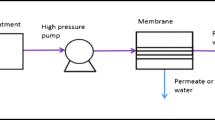Abstract
The debate about the water resources shortages and finding appropriate solutions to close the water gap in many regions is still not finished. The Mediterranean region is among the most arid regions in the world and hosts more than the half of the world’s water-poor population. The situation is more severe in the southern shore of the Mediterranean, in particular, the Maghreb countries. In this region, water resources are very limited and polluted and most countries rely on groundwater yet overexploited. On the other hand, several factors, including rapid economic growth, expanding populations and changing climate, are driving up demand for water. This pushes forward the Maghreb countries to more and more rely on non-conventional and costly water resources such as wastewater treatment and desalination. Obviously, this bears a heavy burden on the economic growth within these countries. In this paper, rationalizing the virtual water trade and enhancing desalination using renewable energy are presented as two promising options to bridging the Maghreb’s water gap.

Source: own construction based on data from FAO (2015)

Source: own construction based on data from FAO (2015)

Source: Mekonnen and Hoekstra (2011)

Source: Dermody et al. (2014)

Source: IRENA (2015)

Source: www.nurenergie.com
Similar content being viewed by others
Notes
Hydrologists typically assess scarcity by looking at the population-water equation. An area is experiencing water stress when annual water supplies drop below 1700 m3 per person. When annual water supplies drop below 1000 m3 per person, the population faces water scarcity, and below 500 m3 ‘absolute scarcity.’ (http://www.un.org/waterforlifedecade/scarcity.html).
References
Canovas Cuenca, J. (2012). Report on water desalination status in the Mediterranean countries. Murcia: Instituto Murciano de Investigación y Desarrollo Agrario y Alimentario (IMIDA).
de Châtel, F., Holst-Warhaft, G., & Steenhuis, T. (2014). Water scarcity, security and democracy: A Mediterranean mosaic. Athens, Ithaca: Global Water Partnership Mediterranean, Cornell University and the Atkinson Center for a Sustainable Future.
Dermody, B. J., et al. (2014). A virtual water network of the Roman world. Hydrology and Earth System Sciences, 18, 5025–5040.
Elbeydi, K. R. (2013). Causal relationship between agricultural output and economic growth in Libya: Co-integration and error correction model. In The global conference on business, economics and social sciences, June 25–26, 2013, Kuala Lumpur, Malaysia.
FAO. (2015). AQUASTAT database. http://www.fao.org/nr/water/aquastat/data/query/.
Future Water. (2011). Middle-east northern Africa water outlook: Final report, commissioned by the World Bank, W. Immerzeel, P. Droogers, W. Terink, J. Hoogeveen, P. Hellegers, and M. Bierkens (auth.). Future water report 98, Wageningen, The Netherlands.
Hoekstra, A. Y., & Hung, P. Q. (2002). Virtual water trade: A quantification of virtual water flows between nations in relation to international crop trade. Value of the water research report series no. 11. Delft: UNESCO-IHE.
Hufbauer, G. C., & Brunel, C. (2008). Maghreb regional and global integration: A dream to be fulfilled. Washington, DC: Peterson Institute Press, All Books, Peterson Institute for International Economics.
IEA-ETSAP & IRENA. (2012). Water desalination using renewable energy: Technology brief. Available at: https://www.irena.org/DocumentDownloads/Publications/IRENA-ETSAP%20Tech%20Brief%20I12%20Water-Desalination.pdf. Accessed January 18, 2015.
IRENA (The International Renewable Energy Agency). (2015). Renewable energy in the water, energy & food nexus. Abu Dhabi: The International Renewable Energy Agency.
Mekonnen, M. M., & Hoekstra, A. Y. (2011). National water footprint accounts: The green, blue and grey water footprint of production and consumption, value of water research report series no. 50. Delft: UNESCO-IHE.
Olsson, G. (2015). Water and energy: Threats and opportunities (2nd ed.). London: IWA Publishing.
UNDP (United Nations Development Programme). (2006). Human development report 2006, beyond scarcity: Power, poverty and the global water crisis. New York: The United Nations Development Programme.
World Bank. (2015). World development indicators. Online database.
World Water Council. (2004). E-conference synthesis: Virtual water trade-conscious choices. The Hague: World Water Council.
WWAP (United Nations World Water Assessment Programme). (2015). The United Nations world water development report 2015: Water for a sustainable world. Paris: UNESCO.
Author information
Authors and Affiliations
Corresponding author
Rights and permissions
About this article
Cite this article
Sebri, M. Bridging the Maghreb’s water gap: from rationalizing the virtual water trade to enhancing the renewable energy desalination. Environ Dev Sustain 19, 1673–1684 (2017). https://doi.org/10.1007/s10668-016-9820-9
Received:
Accepted:
Published:
Issue Date:
DOI: https://doi.org/10.1007/s10668-016-9820-9





